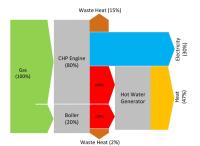 Add My Company
Add My Company
Sign In
CHP for energy managers
30-11-2015

With the Paris Climate Change Summit at the end of 2015 and as the country continues to seek economical ways to reduce carbon output, a technology that has been a niche option is increasingly being investigated by building and energy managers.
At a CIBSE sponsored CPD seminar in Croydon, Arup’s Luke Bannar-Martin provided a packed room with a tremendous insight into the financial and environmental benefits of Combined Heat and Power (CHP, or cogeneration). CHP units provide electricity and heat from a single local unit.
The very low cost of the electricity produced by such systems yields savings that will normally ensure that the installation costs are covered within 5-6 years and the electricity savings then continue for many years. The heat produced by CHP is similar in cost to the use of gas in a conventional boiler.
CHP systems range from gas fired engines and turbines through to biomass and fuel cell systems. Each of these techniques has its place in terms of carbon reduction and overall efficiency but the gas powered engine is the most appropriate for medium to large sized buildings.
Gas engines offer a range of benefits that will apply to many sites:
High electrical efficiency – which gets higher with larger units
Proven reliability at a range of sizes
Good availability
Low cost per kW
Rapid response times
Good performance across a range of outputs
There are many drivers compelling engineers to look at reducing the use of energy and CO2 that favour the consideration of CHP.
The introduction of Part L into Building Regulations, the Carbon Reduction Commitment and Climate Change Levy all compel developers and engineers to move energy efficiency up their list of important considerations. As part of the London Plan, The Decentralised Energy Project Delivery Unit was set up with the objective of delivering 25% of London’s power from local sources by 2025.
Gas Engines
At the level of a single building the use of gas engines is particularly compelling. The graph below demonstrates the highly linear efficiency response of CHP engines across a range of sizes.
Electricity is provide to the building at the right voltage to ensure that its use reduces the electricity imported from the grid, dramatically reducing electricity bills. Meanwhile heat is harvested from the engine cooling and exhaust systems and can be used to heat water and provide space heating.
The key to ensuring that savings from CHP are maximised is an accurate assessment of the heat required throughout the year and matching of the CHP unit to that annual profile with 6,000 running hours per annum providing the best return on investment in most models.
Sites with a year round hot water load consequently offer amongst the best candidates for an installation. Systems that have been correctly sized will almost invariably show a payback of less than 5 years at today’s energy prices as well as offering a significant reduction in CO2 emissions.
Typical sites within this category include:
Hotels
Industrial processes
Leisure Centres with pools
Care homes
With the demise of many of the Government sponsored interventions for carbon reduction, it is good to find a technology that can be planned in for future projects capable of standing on its own financially and free of the vagaries of additional incentives.
Find out more. Call isoenergy on 01293 821345 or email energy@iso.co.uk and we will make a free initial assessment of your premises and the results you might expect.
For more information on CHP for energy managers talk to ISO Energy Ltd
Enquire Now
List your company on FindTheNeedle.
